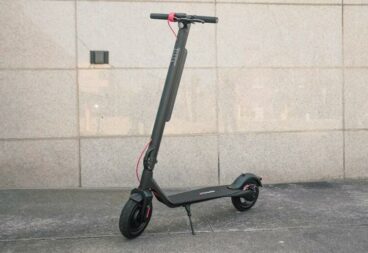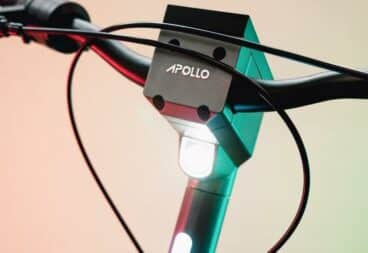
Apollo Phantom (52V)
$1,999
In this Apollo Phantom review, discover how Apollo updated one of the most anticipated scooters of 2021. Plus, performance tests (fully updated by ESG-labs) revealing improved range vs the Phantom V1.
As predicted, other scooters have followed in its feature-rich path, but the Phantom still may be the most complete, ready-for-anything package, right out of the box.
Technical Specifications
| Tested top speed: 39.7 mph* | |
| Tested range: 31.4 mi* | |
| Weight: 76 lb* | |
| Max rider weight: 300 lb | |
| Water resistance: IP54 |
Highlights
| Gorgeous unique design | |
| Standout lighting package | |
| Best overall ride ergonomics | |
| Best next-gen display | |
| Updated stronger kickstand | |
| No bell or front turn signals |
Our content is independent, but buying through our links may earn us a commission.
Summary
Subscribe to our channel for more great videos.
Our Take: Next-Gen Innovation + Standout Design
The Phantom is the first electric scooter fully designed by Apollo’s in-house team based on feedback from thousands of riders. Evolving their development process through several prototypes, Apollo set out to create the best overall riding experience, and in our opinion, they’ve succeeded.
Aside from outstanding ergonomics and ride quality, it has a superior feature package. Still, the best we’ve ever seen — including a now brighter, supersized display, rock-solid triple-secure folding mechanism, and fantastic lighting package, to name a few.
When the Phantom V1 was released, it had so many standout features that we weren’t even sure what to compare it to. The next-level display and folding mechanism, the comfortable cockpit, and lights make it great for commuting, day or night.
2021 has been full of impressive releases, but we’re still hard-pressed to find a light heavyweight scooter that covers all the bases as well as the Phantom V2.
The 52V Phantom is available with or without hydraulic brakes. A 60V model and a 60V Ludicrous variant have been rumored but have yet to emerge for sale.
Ok, maybe more than a rumor; we’ve actually tested a V1 Phantom Ludo Prototype at ESG. Our guess is that a Ludicrous version was delayed because Apollo focused on fulfilling larger than expected orders for the 52V Phantom.
Best Alternatives and Competitors
| Model | Top Speed** | Range** | Weight** | Price |
| Apollo Phantom (52V) | 39.7 mph | 31.4 mi | 76 lb | $1,999 |
| Inokim OXO | 36.7 mph | 36.6 mi | 75 lb | $2,599 |
| Vsett 10+ | 43.3 mph | 33.6 mi | 80 lb | $2,190 |
| Kaabo Wolf Warrior X | 44.1 mph | 32.0 mi | 80 lb | $1,899 |
Is It Good For Bigger, Heavier Riders? – Yes.
Big Dawgs are larger riders that are over 200 lbs and 6 feet or taller, often favoring oversized decks, tall handlebars, pneumatic tires, and suspension.
Big Dawg worthy power with awesome quad suspension
We’re going to be upfront about this one, big dawgs will like the Phantom. It’s built to handle riders up to 300 lbs and has quad spring suspension while most other Pro level scooters have dual spring or something similar.
As soon as you grab the grips and handlebars, you feel connected to the scooter. As a big dawg, Ramier wasn’t in love with the Apollo Pro, the Phantom’s predecessor, because it felt really bouncy. On the Phantom, he can go really fast and stay really stable, and he really, really likes it.
The Phantom is absolutely big dawg approved.
We recommend adding one turn of preload to each spring for each 50 lbs beyond 150 lbs, up to two turns. So a 250 lb or heavier rider would want to add two full rotations to the preload adjusters of each spring.
Apollo Phantom (52V) Review
Performance Summary
| Acceleration (0 to 15 mph) | 2.7 seconds |
| Acceleration (0 to 20 mph) | 3.9 seconds |
| Acceleration (0 to 25 mph) | 5.8 seconds |
| Acceleration (0 to 30 mph) | 8.5 seconds |
| Acceleration (0 to 35 mph) | 13.5 seconds |
| Top speed | 39.7 mph |
| Braking distance (15 to 0 mph) | 10.4 feet |
| Range | 31.4 miles |
| Hill climb | 9.1 seconds |
Note: All analyses and performance results below are for the Apollo Phantom (52V) model. We will be testing the Phantom Ludicrous (60V) model and publishing its performance when the model is ready for market.
Top Speed
In our performance tests with a 165 lb rider and the scooter set in its highest performance mode, the Phantom has a certified top speed of 39.7 mph, gaining 0.6 mph vs. the V1 Phantom.
Compare this with the performance of other scooters we’ve tested.
Acceleration
The Phantom has great acceleration but doesn’t launch with arm-yanking torque.
The initial acceleration of the V2 has been smoothed out slightly relative to the V1, reaching 15 mph in 2.7 s. (0.1 seconds slower than the V1).
On the other hand, our test revealed faster top-end acceleration. The V2 hits 35 mph in 13.5 s vs. 13.7 s seconds for the V1.
Hill Climb
The Phantom (52V) climbed the 10% average grade, 200-ft incline in 9.1 s (0.1 sec faster than V1) with an average speed of 15.0 mph with our 165-lb rider.
While the uphill acceleration isn’t likely to give you an adrenaline rush, the V2 will sustain >30 mph up typical city hills, so it has no trouble keeping up with cars.
Smooth and fast is how the V2 rolls.
Range
The Phantom V2 surprised us with 10% more range than we measured on the original Phantom, coming in at 31.4 miles of range in top speed mode (gear 3, Sport Mode) with a 165 lb rider.
It was a clean win too. The V2 test data shows a slightly higher average speed during the V2 range test than the V1 test (0.9 mph faster on average).
With 31.4 miles of real-world range, the Phantom V2 can easily take you the distance when it comes to daily commuting or weekend sport riding.
Braking
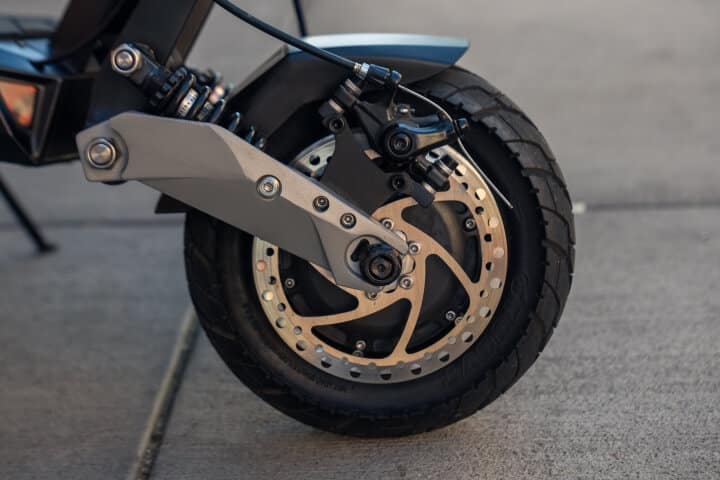
When it comes to safe braking distances, anything under 12 ft is excellent.
Our Phantom V2 (52V) with Nutt hydraulic brakes comes to a stop from 15 mph in 10.4 ft, so those supersized 160 mm discs are doing their job.
Our Phantom V2, equipped with mechanical disc brakes, came to a stop from 15 mph in 10.4 ft (0.2 ft shorter than the V1 Phantom with Nutt hydraulic brakes).
Both the V1 and V2 have the same huge 160 mm rotors, but the V2 has revised brake pads for better stopping distance and better resistance to squeaking.
Ride Quality
We ride some of the best scooters in the world, and the Apollo Phantom V2 stands out for its fast-and-smooth riding style. It’s the result of a combination of ride quality features that is unmatched by any other scooter we’ve seen. There isn’t a particular element that stands out from the rest of the scooter, and that’s what’s good about it.
It just all works very well together: everything from the improved (V2) thumb throttle, ultra ergonomic grips, and bars to the long grippy deck and quad spring suspension. It’s hard to quantify, but it just feels really really good to ride.
Overall, the Phantom’s cockpit is built for riding comfortably with well-appointed components. The display and buttons look and feel high quality, and the wide handlebars angle back nicely toward you. The grips have the most ergonomic shape of any we’ve tested, though we wish they had clamps to prevent them from rotating. It’s a minor annoyance that you can fix with grip glue or even hairspray.
Both the mechanical disc brakes of our V2 and the hydraulic brakes on our original Phantom feel great and make it easy to brake hard without locking up.
If we have a complaint about braking, it would be that the brakes on the V1 were possibly a little too strong in terms of initial bite. The revised brake pads on our V2 didn’t have that issue.
Apollo says the new brake pad compound also lasts longer.
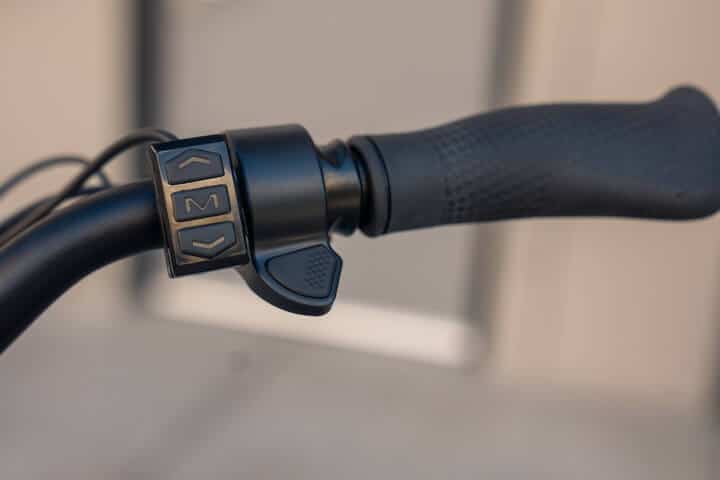
In our opinion, a well-designed thumb throttle beats a trigger throttle all day because of the throttle/brake ergonomics. The problem is: mechanically, most thumb throttles aren’t designed very well. When the V1 came out, we called out the cheap feel of the hard-plastic lever but ultimately liked the Phantom V1’s thumb throttle because it kept our brake-fingers from getting cramped up during long rides.
The new rubberized, reduced dead-zone thumb throttle on the Phantom V2 is a welcome upgrade and is probably the most noticeable update.
All throttles have some dead-zone (4 to 6.5 mm) at the beginning of travel, but at 14 mm, the V1 throttle had more dead-zone than most.
The improved throttle brings the Phantom V2 back in-line with the range most riders are used to with 6 mm of travel before engaging.
Thumb throttles are awesome but require a little technique to get the best out of them. The main thing to remember is; whenever possible, you need to “anchor” your thumb.
Plant your knuckle on the grip, and then rock the tip of your thumb into the throttle. Doing so de-couples your thumb from your arm, so bumps in the road won’t make it from your arm to your thumb.
Anchoring isn’t as crucial on low-power scooters since the throttle is almost always at 0% or 100%. However, when riding a dual-motor scooter with a thumb throttle, anchoring your thumb changes everything.
For anyone who has a V1 Phantom, we have some good news for you. Apollo will ship a new V2 throttle to you as part of a free upgrade kit. They even have an excellent video about how to install it. Reach out to your dealer to order your free kit. (You’ll still have to pay for shipping).
There is one feature that you’ll lose in the throttle swap. The key-switch gets deleted since it’s part of the V1 throttle. We haven’t been fans of key-switches for a while because of reliability issues, so we’re glad to see the keyswitch go. More than once, I’ve had to swap out a dead key-switch to go for a ride.
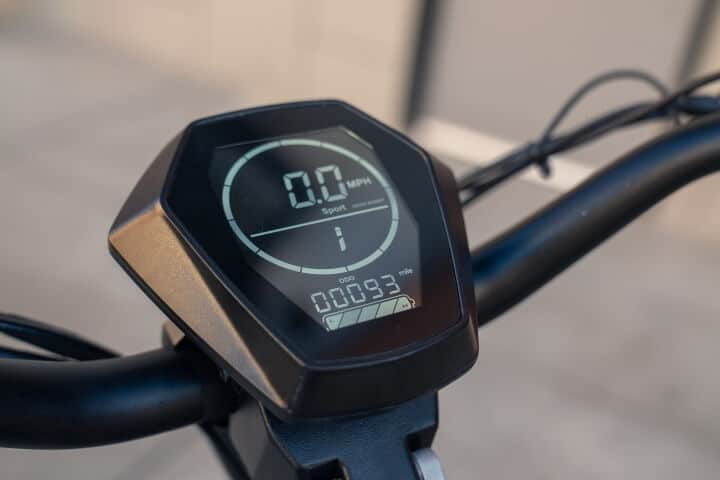
The second most noticeable upgrade is the new (much) brighter and ever-gorgeous hex display. It’s attractive, well laid out, and the perfect centerpiece for daily commuting. It’s supersized compared to most displays and has super intelligent functionality, providing on-screen indicators for everything a rider needs to know. It even shows you when your turn signals are on.
In our previous review, we called out the display for being difficult to read in bright sunlight, but it still made our list of favorite things about the V1. Now, it’s once again a contender for best display ever.
V1 owners, you’re in luck here once again. The free upgrade kit also includes an upgraded, brighter display. Be sure to peel off the protective film when you install it. It’s to protect from scratches during shipment, not to block glare.
Be sure to keep your original parts and don’t throw them away. If you ever destroy your new display or throttle or need a known-good part for diagnostics, you’ll have spares on hand! That’s something V2 owners don’t get.
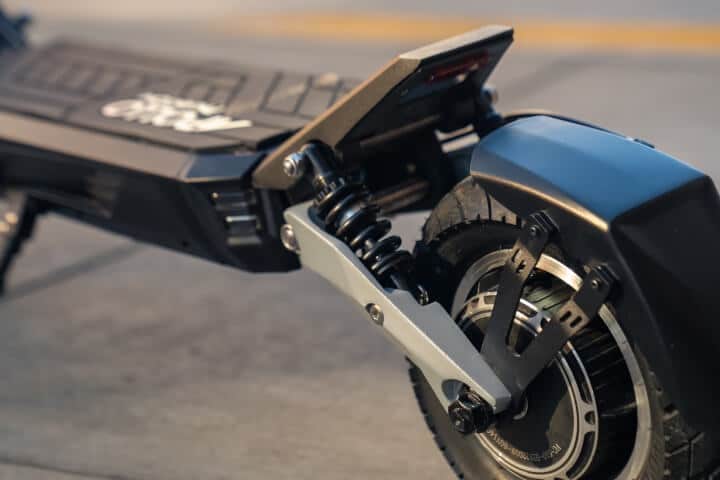
Now let’s talk about what’s under your feet. The Phantom is the first scooter we’ve tested with quadruple spring suspension, and it straight up beats all other spring suspension styles out there. The Phantom’s design includes a rubber bump stop to prevent you from feeling it topping and bottoming out harshly. It’s effective at reducing the trampoline effect you can get with bouncy spring suspension.
The front end of the Phantom feels slightly better than the Vsett 10+. The 10+ has the advantage of a hydraulic rear shock, but all together, suspension on the Phantom feels slightly better, especially after a couple of weeks of riding.
Speaking of what’s under your feet: the V2 also has an updated logo on the deck that’s more durable. The white color is embedded in the deck rubber rather than added on top of the deck. The new deck rubber isn’t included in the free upgrade kit but will be available as a spare part.
Apollo Phantom Features
Portability

Is the Phantom super portable? No, not really, it’s a pretty average weight for a dual motor scooter at 77 lbs.
The Phantom measures 49 in long by 27 in wide by 21 in tall when folded.
The handlebars are 27 in wide and do not fold, so that’s something to keep in mind when transporting or trying to walk the Phantom through a narrow space. It just barely passes our trunk test.
The stem-folding mechanism is straightforward to engage and disengage, and the stem feels completely solid when latched into riding-position: zero wobble, zero flex. One of the very best stems out there.
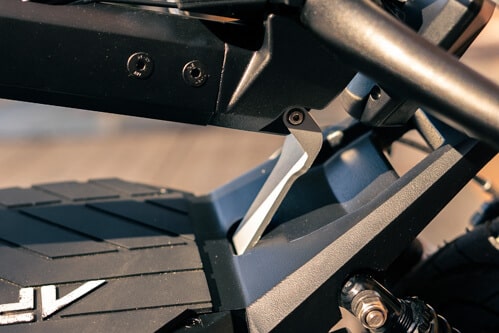
The stem latches conveniently to the footrest, and the stem width is narrow enough to grip one-handed. The cutout on the footrest makes a good hand-hold for lifting the scooter into a trunk and avoids the stem unlatching from the deck, which can happen if you lift via the stem.
While we love the footrest hand-hold, it can let water spray through when riding in the rain. Fortunately, it’s small enough that riding with your foot on the rear footrest completely blocks water spray from getting through.
Even though the key switch is gone on the V2, the Phantom is still one of the easiest scooters to secure outside for short visits to the store, since there are several prominent places to lock it. Of course, always bring it inside, if you can.
Cockpit
The cockpit is where the Phantom takes innovation to another level. The handlebars are very wide at 27 in, and capped with rubberized hand grips that have a plushy, ergonomic feel. Although they feel great, they’re not screwed-in, so they can rotate while riding.
The proprietary HEX display is centered over the handlebars, gorgeous and fully next-gen. We think this display marks the beginning of the end for the typical displays used on other scooters (i.e., QSS4 and EY3). All of the electronics along the handlebars of the Phantom V2, including the hex display, are now plug-and-play, making it easier to replace components.
Here again, good news for V1 owners. The upgraded display comes with new mode buttons with plug-and-play connectors. The cables are partially exposed on both models for ease of service but are wrapped in a more finished-looking way on the V2, with slightly improved cable lengths (not too short, not too long).
One of the hex display’s most ambitious features is that it reports remaining mileage based on battery voltage.
We didn’t test the accuracy of the remaining-miles feature during the V1 range test. When we tested it on the V2 Phantom, we found that it was optimistic by 12 miles throughout our 31.4-mile range test (3rd gear and Sport mode).
If you ride like we do, be sure to subtract 12 miles from the remaining-miles, and you’ll make it home. If you tend to ride in single-motor (normal mode), your mileage may not vary as much (YMMNVAM) from the Phantom’s indicated miles remaining.
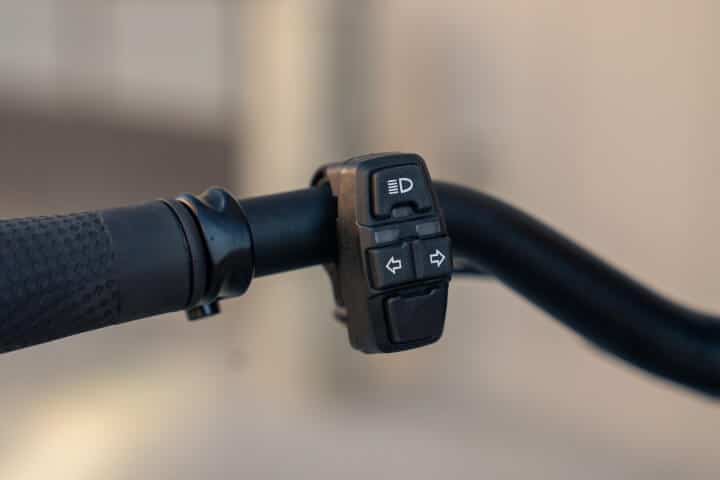
On the left handlebar, there’s the rear brake lever, button console to control the lights (headlight and turn signals), and an unlabeled button that enables dual motor (sport) mode, but no bell (we recommend adding one).

On the right handlebar, there’s the front brake lever, thumb throttle, and three-way button console that allows you to power on the Phantom, switch riding modes and toggle through features on your display.
Phantom P-settings
As the Phantom has an all-new proprietary display, it also has its own P-settings. To access P-settings, power on the scooter and press the up/down directional buttons simultaneously for 3 seconds. Use the mode button to cycle through and lock in your settings, and the directional buttons to change the value.
These settings are also in the user manual.
| Setting | Function |
|---|---|
| P01 | Display brightness 1: dark, 2: bright, 3: brightest Default: 2 |
| P02 | Units 0: Imperial (miles) 1: Metric (kilometers) |
| P03 | Battery voltage Min: 24V, Max: 72V Default: 52V (matching scooter voltage) |
| P04 | Auto shut-off timer Min: 1 min, Max: 60 min Default: 30 min |
| P05 | Not used |
| P06 | Wheel diameter: 10 in |
| P07 | Motor magnets Min: 1, Max: 100 Default: 30 |
| P08 | Performance limiter Min: 5%, Max: 100% |
| P09 | Start style Zero start: 0, Kick-to-start: 1 |
| P10 | Not used |
| P11 | Electric brake strength Min: 0, Max: 3 |
| P12 | Acceleration strength Min: 1, Max: 5 Default: 4 (ESG Performance Test: 5) |
| P13 | Not used |
| P14 | Not used |
| P15 | Controller cutoff voltage Min (52V): 42V, Min (60V): 48V |
| P16 | Odometer reset (Press gear up/down to reset) |
| P17 | Cruise control 0: off, 1: on (Maintain constant speed for 5 seconds to engage) |
Lights
While the Phantom has an overall comprehensive feature set, Apollo has included two standout features that put this scooter above nearly any other when it comes to safety: a built-in 1000 lumen headlight and real turn signals, all with on-screen indicators.
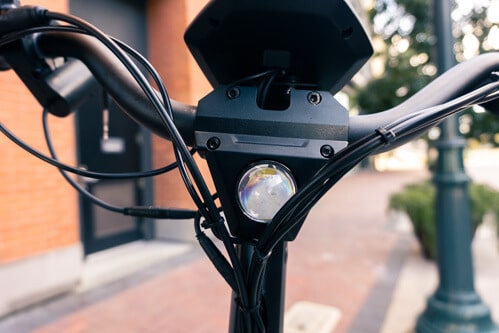
Although you wouldn’t buy a car without headlights, you might own a performance scooter without one. Adequate lighting is often overlooked as a required feature of powerful scooters. If you ride at night, you know what it’s like. To have better visibility, you have to purchase, attach, charge, and keep track of separate lights on top of your other gear, which is just a lot.
The Phantom’s lighting package is pretty close to perfect, as the high-mounted headlight, front deck lights, and bright orange rear turn signals are easily visible in daytime and nighttime.
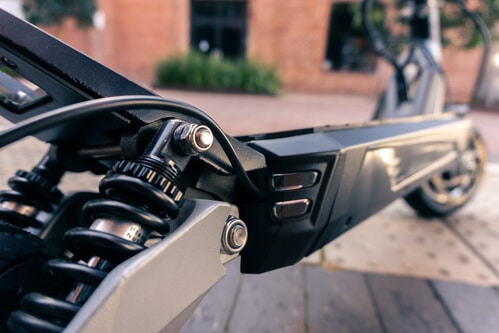
The only downside to the lighting configuration is that the turn signals are only on the rear, meaning drivers facing you won’t know if you’re turning against them in traffic. We hope Apollo will switch the front deck lights to turn signals and add under-deck or stem lighting in future models.
Tires
The TOUVT-brand tires on the Apollo Phantom are, simply put, the best feeling tires ever fitted to a production scooter. They are large in both dimensions with a 10 inch diameter and width of 3 inch, and have the best profile for sporty riding: quick steering when vertical and slow-stable steering when leaned over.
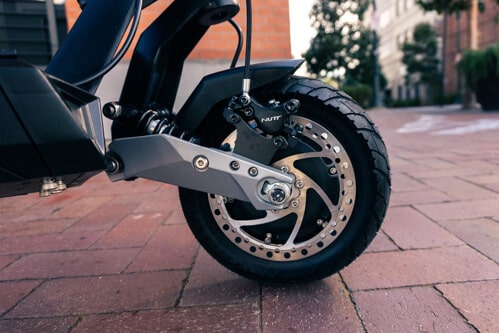
The TOUVT-brand tires on the Apollo Phantom are, simply put, the best feeling tires ever fitted to a production scooter. They are large in both dimensions with a 10.0 in diameter and width of 3 in, and have the best profile for sporty riding: quick steering when vertical and slow-stable steering when leaned over.
Traction is very good at any lean angle. The recommended 50 psi feels overinflated on these tires and contributes to the occasional power-skitter of the front tire over high-frequency road defects. If you can give up a few miles of range per charge, we recommend running the tires at 45 psi for an improved ride and even better traction.
The tires on the Phantom are pneumatic (inner tube) tires on a split rim for easy tire changes, and in case it wasn’t clear, we really, really like them.
In response to rider feedback, the Phantom V2 comes with higher-quality inner tubes that are more resistant to pinch flats.
As always, though, any air-filled tire is going to be prone to punctures and flats. Follow our preventive guide to avoid them.
Deck
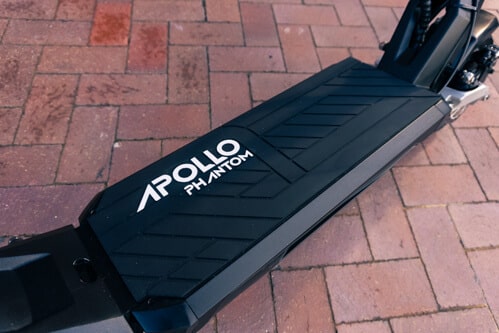
The rubberized deck is gorgeous and should be easy to keep clean. With the new molded-in logo, it will stay looking like-new longer. The deck surface has deep grooves in the all-black pattern and measures 20.5 in long by 7.0 in wide. It has 5.8 inches of ground clearance.
It is long enough to fit both feet, but you’ve also got a good-sized, well-angled footrest for added standing room. It’s one of the few decks that doesn’t leave our feet searching for another inch of space while riding. In our opinion, the Phantom’s deck is “just right.”
A thoughtful part of the folding hook design is that it attaches to a recessed anchor point in the footrest rather than onto the deck, meaning you won’t be stepping on it like on some other scooters (we’re looking at you Minimotors).
Build Quality
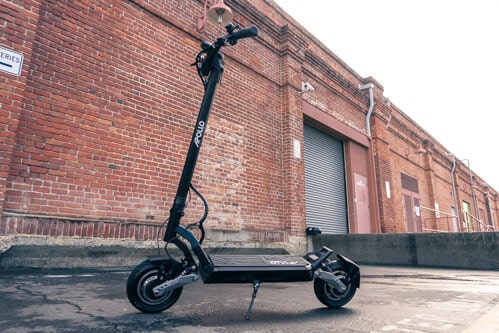
Before our first-gen Phantom arrived at ESG Labs, it had already gone through three evolutions. Apollo experimented with tubeless tires, tested different motor styles, and fine-tuned how the fenders, folding hook, and stem folding mechanism all come together.
With that, the Phantom V1 felt like a well-evolved machine.
There is no better test than the real world, though. So, Apollo tracked rider feedback and used what they learned to evolve the Phantom through one more iteration: the Phantom V2.
We’ve touched on the updates, but here is a comprehensive list of changes. Items in bold come with the free upgrade kit for V1 owners. If you’re a V1 owner, you can order your upgrade kit through your local Apollo dealer.
- New throttle. Reduced dead zone
- New display. Brighter. Higher refresh rate
- Plug and play mode buttons for more straightforward service
- New side plastic covers
- New front plastic covers (only for mechanical brake)
- Higher quality brake pads (longer life, less squeak)
- Higher quality inner tubes (less prone to pinch flats)
- New brake light (deeper red than V1)
- Better cable management out of the box
- New, stronger kickstand
- Screw-on charging port covers won’t fall off
- The right logo on the stem was flipped 180 Degrees
- Safety catch for stem-latch now made of more robust plastic
- More durable paint (more scratch resistant)
- Thicker, stronger frame at gooseneck
- Tether for the grenade-pin prevents you from losing the pin
- Updated motor controllers have smoother launch (no stutter)
- Key has been deleted (more reliable, but mostly a side effect of changing throttle type)
- 1 lbs heavier than the V1
Folding mechanism
One of our favorite things, which hasn’t changed, is the folding mechanism for the stem. The Phantom uses a claw-style folding mechanism with a safety feature we’ve dubbed the grenade pin. This system is rock solid with zero wobble, as the mechanism and stem, made from double-layer aluminum, are bolted and welded together.
The folding mechanism feels familiar as it’s very similar to one of the world’s most popular scooters, the Ninebot Max, but with an added grenade-pin safety feature. It can also develop a familiar Dualtron-esque stem creak over time.
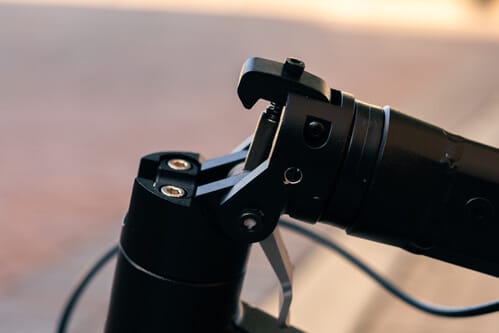
Not to fear, the solution is straightforward to apply. Spray a little lithium grease into the mating surfaces of the stem latch.
To set the scooter upright, unfold the stem, push the lever upwards, rotate the collar to secure the lever in place, and press the safety pin through the stem. The stem is left feeling very, very solid.
The V2 now includes a leash for the safety pin. However, you can also fit the pin back into the hole once folded to keep the pin from bouncing around in transit.

One of the most rider-focused features that Apollo has implemented with the Phantom is its repairability. Along with the plug-and-play components in the cockpit, the Phantom has pneumatic tires mounted on split rims, as they provide the best balance of ride quality and ease of maintenance.
Additionally, all Phantom scooters come packaged with a premium toolkit featuring tools, spare inner tubes, and brake pads in a zippered pouch.
Although not waterproof, the Phantom V1 and V2 have IP54 water resistance ratings like all other Apollo scooters. A quick caveat about IP ratings: no retailer warranty that we know of covers any water-related damage, IP rating or not.
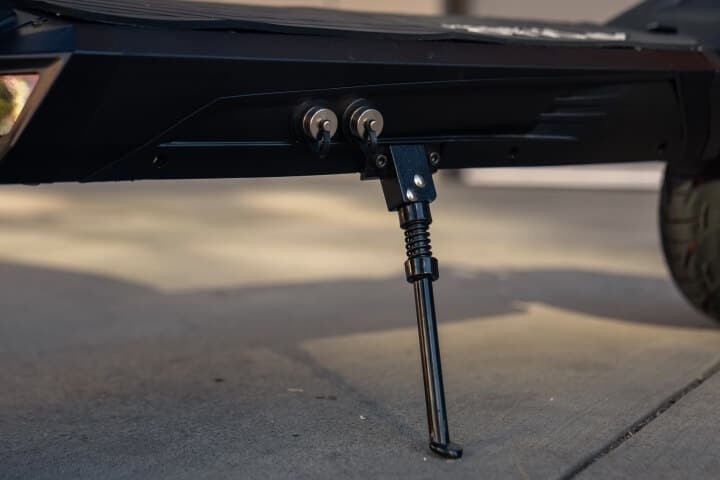
When initially launched, the kickstand mount on the Phantom V1 was already massively reinforced, but the kickstand itself wasn’t the same level of quality as the rest of the scooter. It stuck out too much from the deck when folded, causing the scooter to lean over too much when parked, and its aluminum construction made it prone to bending during use. The Phantom V2 now comes with a steel kickstand which feels much more robust.
On both versions, the side-stand acts as a crash-slider, protecting the charge ports in the event of a tip-over. The V2 takes charge-port protection a step further, adding knurled metal screw-on covers that won’t fall off and look cool.
Apollo Phantom: Review Conclusions
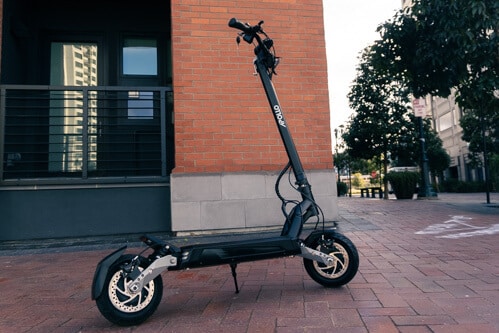
The Phantom V1 threw down the gauntlet with the most complete feature-set we’d ever seen, an all-new scooter.
Enter the Phantom V2: with even better build quality, smoother performance, and updated commuter-friendly features, the V2 is an exceptional all-arounder, maybe the best all-arounder.
It has the speed to keep up with traffic, even uphill. Unique, quad-suspension that takes mid-corner bumps with confidence. The best tires you’re going to find on any production scooter. Rockin ergonomics and a super bright high-mounted headlight, meaning you’ll have one less thing to carry with you riding at night (no external lights required).
It’s a comfortable, intuitive ride, one of the most complete packages right out of the box, and most importantly: it’s just really fun to ride.
The Phantom is exceptional with amazing build quality, solid performance, and commuter-friendly features suitable for riders looking to jump on their scoots every day. You’ll feel comfortable driving with traffic when needed, taking bumps and corners on the quad spring suspension, and have less to carry with you riding at night (you won’t need all those extra lights!).
If you can wait and want blazing, rubber-burning speed, the 60V Phantom Ludicrous is ridiculously fast on top of the complete feature set that you’re getting with the Phantom (no matter the power).
If the Apollo line doesn’t fit your needs, check out our ESG Editor’s pick of best electric scooters.
Our content is independent, but buying through our links may earn us a commission.
Apollo Phantom Specifications
| Make | Apollo |
| Model | Phantom (52V) |
| Weight | 77 lb |
| Folded dimensions | 49 by 27 by 21 in |
| Motor power, continuous | 2400 W |
| Top speed | 38 mph |
| Range | 40 mi |
| Battery capacity | 1216 Wh |
| Battery recharge time | 12 to 14 hrs |
| Max rider weight | 300 lb |
| Brake type | Disc + Disc |
| Tire type | 10.0 in Pneumatic (Inner Tube) + Pneumatic (Inner Tube) |
| Built-in lights | Front + Rear |
| Water resistance | IP54 |



